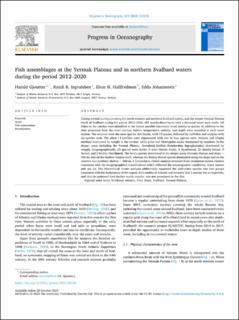| dc.description.abstract | During several surveys covering the north-western and northern Svalbard waters, and the deeper Yermak Plateau north of Svalbard during the period 2012–2020, 291 standardized hauls with a demersal trawl were made. All fishes in the catches were identified to the lowest possible taxonomic level, mostly to species. In addition to the data generated from the trawl catches, bottom temperature, salinity, and depth were recorded at each trawl station. The eelpouts were the most species rich family, with 15 species, followed by codfishes and sculpins with six species each. The other 13 families were represented with one to four species each. Atlantic cod (Gadus morhua) dominated by weight in the catches, while polar cod (Boreogadus saida) dominated by numbers. In the deeper areas including the Yermak Plateau, Greenland halibut (Reinhardtius hippoglossoides) dominated by weight. Zoogeographically, 23 species were Arctic, 5 were Mainly Arctic, 4 Arctoboreal, 25 Mainly Boreal, 9 Boreal, and 2 Widely Distributed. The Arctic species dominated in the deeper areas (Yermak Plateau and slope > 500 m) and on the shallow eastern shelf, whereas the Mainly Boreal species dominated along the slope and on the western and northern shelves < 500 m. A hierarchical cluster analysis revealed three prominent station clusters consistent with the zoogeographical classifications which reflected the oceanographic conditions, water masses and sea ice. The hierarchical cluster analysis additionally separated the cold-water species into two groups consistent with the bathymetry of the region. Diet studies of Atlantic cod revealed that it mainly fed on hyperiids, and that its preferred food further south, capelin, was not prominent in the diet. | en_US |
